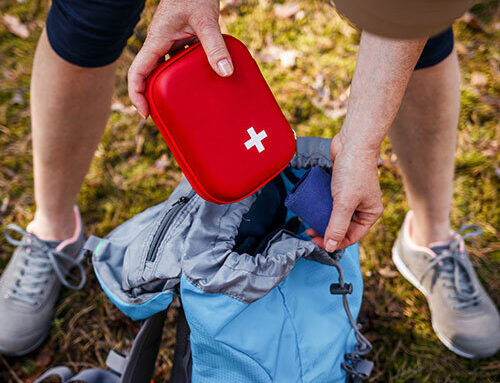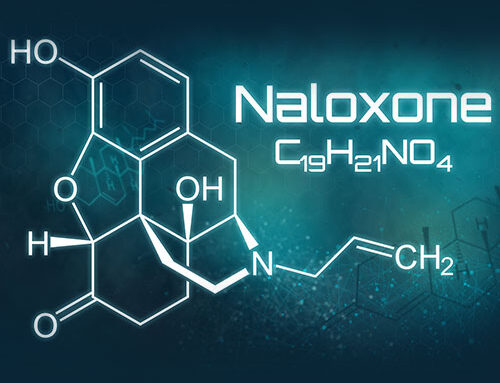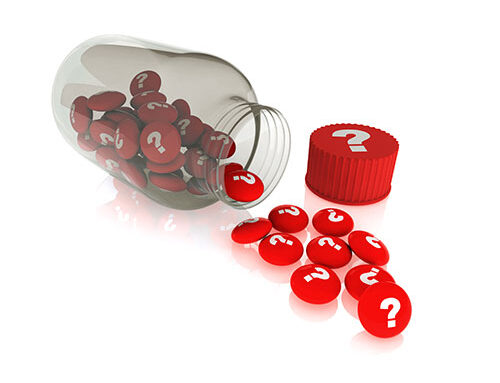 In 2019, an analysis conducted by the National Safety Council found that, for the first time in US history, a person is more likely to die from an accidental opioid overdose than in a motor vehicle crash.1 We don’t plan to get into car accidents, yet we are prepared with seat belts and air bags. Similarly, if we are prescribed opioids, we should prepare for emergencies like accidental opioid overdose by keeping an overdose reversal medication such as Kloxxado® (naloxone HCl) Nasal Spray on hand.2 Accidental opioid overdose is the #1 cause of accidental death in the US.1 It is also the #1 reason why you need Kloxxado® (naloxone HCl) Nasal Spray in your home if you take prescription opioids.
In 2019, an analysis conducted by the National Safety Council found that, for the first time in US history, a person is more likely to die from an accidental opioid overdose than in a motor vehicle crash.1 We don’t plan to get into car accidents, yet we are prepared with seat belts and air bags. Similarly, if we are prescribed opioids, we should prepare for emergencies like accidental opioid overdose by keeping an overdose reversal medication such as Kloxxado® (naloxone HCl) Nasal Spray on hand.2 Accidental opioid overdose is the #1 cause of accidental death in the US.1 It is also the #1 reason why you need Kloxxado® (naloxone HCl) Nasal Spray in your home if you take prescription opioids.
The benefits and risks of prescription opioids
When prescribed by a doctor and used as directed, opioid pain medications can safely help control acute pain (as you might have after surgery) and chronic pain (as you might experience with cancer).3,4 However, the properties of prescription opioids that enable them to manage pain are associated with risks.3 If you are prescribed an opioid pain reliever, you need Kloxxado® (naloxone HCl) Nasal Spray in your home.2 Kloxxado® is a potentially life-saving overdose reversal medicine called an opioid antagonist.2 It can be used in an emergency situation to rapidly reverse the effects of accidental opioid overdose.2
Opioid pain relievers are commonly prescribed and widely used
From 2006 to 2012, the number of opioid prescriptions written in the US increased steadily, peaking at more than 255 million in 2012.5 Opioids are still commonly prescribed and widely used.5 In 2019, the overall opioid dispensing rate in the US was 46.7 prescriptions per 100 people—more than 153 million opioid prescriptions total.5 Common prescription opioid medications include6,7:
- hydrocodone (Vicodin®, Norco®, Zohydro®)
- oxycodone (OxyContin®, Percocet®), Percodan®)
- codeine (Tylenol #3®)
- morphine (Avinza®, Duramorph®, MS Contin®)
- fentanyl (Actiq®, Duragesic®, Sublimaze®)
- hydromorphone (Dilaudid®)
- oxymorphone (Opana®)
- buprenorphine (Butrans®, Belbuca®)
Risk factors for accidental opioid overdose
When accidental opioid overdose occurs, breathing can slow down and eventually stop, often resulting in death.8 Anyone who takes prescription opioid medication is at risk for this kind of overdose.8 However, your risk may be higher if you8–10:
- Take high daily dosages of prescription opioids
- Take an opioid with Xanax®, Valium® or other benzodiazepine
- Have certain medical conditions, including sleep apnea or reduced kidney or liver function
- Are 65 years of age or older
- Have had problems managing opioid medications in the past
Causes of accidental opioid overdose
About 80 percent of fatal opioid overdoses are considered unintentional.11 Some common causes of accidental opioid overdose include8:
- Taking an extra dose of a prescription opioid
- Taking doses of a prescription opioid too close together
- Combining a prescription opioid with certain other medicines, such as antidepressants or antianxiety medications
- Mixing a prescription opioid with alcohol or illegal drugs
- Taking a prescription opioid that was prescribed for someone else
One way to reduce the likelihood of death from accidental opioid overdose is to keep an overdose reversal medication like Kloxxado® in your home.12
Kloxxado® can treat accidental opioid overdose2
Death from an accidental opioid overdose happens when too much of the drug overwhelms the brain and interrupts the body’s natural instinct to breathe.13 Naloxone can quickly restore normal breathing in someone who is barely breathing or has stopped breathing altogether as a result of accidental opioid overdose.2 Kloxxado® does not affect a person who does not have opioids in their system, so it can be given even when overdose is suspected—not necessarily confirmed.2 Also important to keep in mind is that Kloxxado® is a nasal spray, not an injection. It is relatively simple to use in an emergency situation, and no medical training is required.2
Kloxxado® can save your life
If you take an opioid pain reliever, you should keep an overdose reversal medicine like Kloxxado® in your home—especially if you have any of the risk factors for accidental opioid overdose. Equally important is that all of the adults who live in your home know how to give overdose reversal medicine. The minutes between an overdose and the arrival of emergency medical personnel could be a matter of life and death.12 Be sure to talk with your doctor to learn more about the risks of accidental opioid overdose, find out how to purchase Kloxxado® to keep in your home and teach your loved ones how to use it in an emergency.
Kloxxado® is a trademark of Hikma Specialty USA Inc.
All other trademarks and registered trademarks are the property of their respective owners.
Important Safety Information About Kloxxado® (naloxone HCl) Nasal Spray
Contraindications
Hypersensitivity to naloxone hydrochloride or to any of the other ingredients
Warnings and Precautions
- Use Kloxxado® right away if you suspect an opioid overdose emergency, even if you are not sure, because an opioid overdose emergency can cause severe injury or death. Signs and symptoms of an opioid overdose emergency may include:
- Unusual sleepiness; you are not able to awaken the person with a loud voice or by rubbing firmly on the middle of their chest (sternum).
- Breathing problems, including slow or shallow breathing in someone difficult to awaken or who looks like they are not breathing.
- The black circle in the center of the colored part of the eye (pupil) is very small (sometimes called “pinpoint pupils”) in someone difficult to awaken.
- Family members, caregivers or other people who may have to use Kloxxado® in an opioid overdose emergency should know where Kloxxado® is stored and how to give Kloxxado® before an opioid overdose emergency happens.
- Get emergency medical help right away after using the first dose of Kloxxado®. Rescue breathing or CPR (cardiopulmonary resuscitation) may be needed while waiting for emergency medical help.
- The signs and symptoms of an opioid overdose emergency can return after Kloxxado® is given. If this happens, give another dose after 2 to 3 minutes, using a new Kloxxado® device, alternating nostrils, and watch the person closely until emergency medical help arrives.
- Do not use Kloxxado® if you are allergic to naloxone hydrochloride or any of the ingredients in Kloxxado®.
- Kloxxado® can cause sudden and severe opioid withdrawal, the symptoms of which may include body aches, diarrhea, increased heart rate, fever, runny nose, sneezing, goosebumps, sweating, yawning, nausea or vomiting, nervousness, restlessness or irritability, shivering or trembling, stomach cramps, weakness and increased blood pressure.
- In infants, opioid withdrawal may be life-threatening if not recognized and properly treated. Infants going through opioid withdrawal may have seizures, cry more than normal, and have increased reflexes.
- Tell your doctor about all of your medical conditions before using Kloxxado®, including if you have heart problems, are pregnant or plan to become pregnant.
- Tell your doctor about all of the medicines you take, including prescription and over-the-counter medicines, drugs, vitamins and herbal supplements.
Side Effects
The following serious side effect is discussed in the full Prescribing Information for Kloxxado®:
- Sudden and Severe Opioid Withdrawal
Symptoms of sudden and severe opioid withdrawal resulting from the use of Kloxxado® in someone regularly using opioids include: body aches, diarrhea, increased heart rate, fever, runny nose, sneezing, goosebumps, sweating, yawning, nausea or vomiting, nervousness, restlessness or irritability, shivering or trembling, stomach cramps, weakness and increased blood pressure.
Infants may have seizures, cry more than normal and have increased reflexes.
Some people may become aggressive after abrupt reversal of opioid overdose.
In two clinical studies, a total of 47 healthy adult volunteers were exposed to a single dose of Kloxxado®, one spray in one nostril. Side effects were reported in two subjects for each of the following: abdominal pain, asthenia, dizziness, headache, nasal discomfort, and presyncope.
These are not all of the possible side effects of Kloxxado®. Contact your doctor for medical advice about side effects.
Pregnancy, Infancy and Breastfeeding, Children
Tell your doctor if you are pregnant or plan to become pregnant. If you are pregnant and opioid dependent, use of Kloxxado® may cause withdrawal symptoms in you and your unborn baby. A healthcare provider should monitor you and your unborn baby right away after you use Kloxxado®.
There is no information regarding the presence of naloxone in human milk, the effects of naloxone on the breastfed infant or on milk production.
If the primary concern is an infant at risk of an overdose, consider whether other naloxone-containing products may be more appropriate.
Kloxxado® nasal spray is safe and effective in children for known or suspected opioid overdose.
Dosage and Administration
Do not attempt to prime or test-fire the device. Each Kloxxado® Nasal Spray contains only 1 dose of medicine and cannot be reused. Read the “instructions for use” at the end of the Prescribing Information and Medication Guide for detailed information about the right way to use Kloxxado® Nasal Spray.
Storage and Handling
Store Kloxxado® at room temperature between 59 F to 77F (15C to 25C). Kloxxado® may be stored for short periods between 39°F to 104°F (4°C to 40°C). Do not store above 40ºC (104ºF). Do not freeze Kloxxado®. Keep Kloxxado® in its box until ready to use. Protect from light. Replace Kloxxado® before the expiration date on the box. Keep Kloxxado® and all medicines out of the reach of children.
Please see the full Prescribing Information and Medication Guide for Kloxxado® for complete product details.
NOTE: This article was not written by a medical professional and is not intended to substitute for the guidance of a physician. These are not Hikma’s recommendations, but rather facts and data collected from various reliable medical sources. For a full list of resources and their attributing links, see below.
HK-1130
References
- For the First Time, We’re More Likely to Die from Accidental Opioid Overdose Than Motor Vehicle Crash. National Safety Council website. Available at: https://www.nsc.org/newsroom/for-the-first-time,-were-more-likely-to-die-from. Accessed February 23, 2021.
- Kloxxado®(naloxone hydrochloride) nasal spray [prescribing information]. Columbus, OH: West-Ward Columbus, Inc.; 2020.
- What are opioids and why are they dangerous? Mayo Clinic website. Available at: https://www.mayoclinic.org/diseases-conditions/prescription-drug-abuse/expert-answers/what-are-opioids/faq-20381270. Accessed February 23, 2021.
- Opioids for Cancer Pain. American Cancer Society website. Available at: https://www.cancer.org/treatment/treatments-and-side-effects/physical-side-effects/pain/opioid-pain-medicines-for-cancer-pain.html. Accessed February 23, 2021.
- US Opioid Dispensing Rate Maps. Centers for Disease Control and Prevention website. Available at: https://www.cdc.gov/drugoverdose/maps/rxrate-maps.html. Accessed February 23, 2021.
- Source: Internal Hikma Analysis, IQVIA NSP Data Audit, USC 3 = Analg Narc, most recent 12 months, accessed 2/15/2021.
- Opioids and Dental Pain. National Institute of Dental and Craniofacial Research. Available at: https://www.nidcr.nih.gov/health-info/opioids/more-info. Accessed March 8, 2021.
- Opioid Overdose. Medline Plus website. Available at: https://medlineplus.gov/opioidoverdose.html. Accessed February 23, 2021.
- Opioid overdose. World Health Organization website. Available at: https://www.who.int/news-room/fact-sheets/detail/opioid-overdose. Accessed February 23, 2021.
- Opioid Overdose Risk Factors. Mass.gov website. Available at: https://www.mass.gov/service-details/opioid-overdose-risk-factors. Accessed March 8, 2021.
- Zedler BK, Saunders WB, Joyce AR, Vick CC, Murrelle EL. Validation of a Screening Risk Index for Serious Prescription Opioid-Induced Respiratory Depression or Overdose in a US Commercial Health Plans Database. Pain Medicine. 2018;19:68–78.
- Life-Saving Naloxone: Review of Currently Approved Products. Practical Pain Management website. Available at: https://www.practicalpainmanagement.com/treatments/pharmacological/opioids/life-saving-naloxone-review-currently-approved-products. Accessed February 23, 2021.
- Drug Facts/Naloxone. National Institute on Drug Abuse website. Available at: https://www.drugabuse.gov/publications/drugfacts/naloxone. Accessed February 23, 2021.





